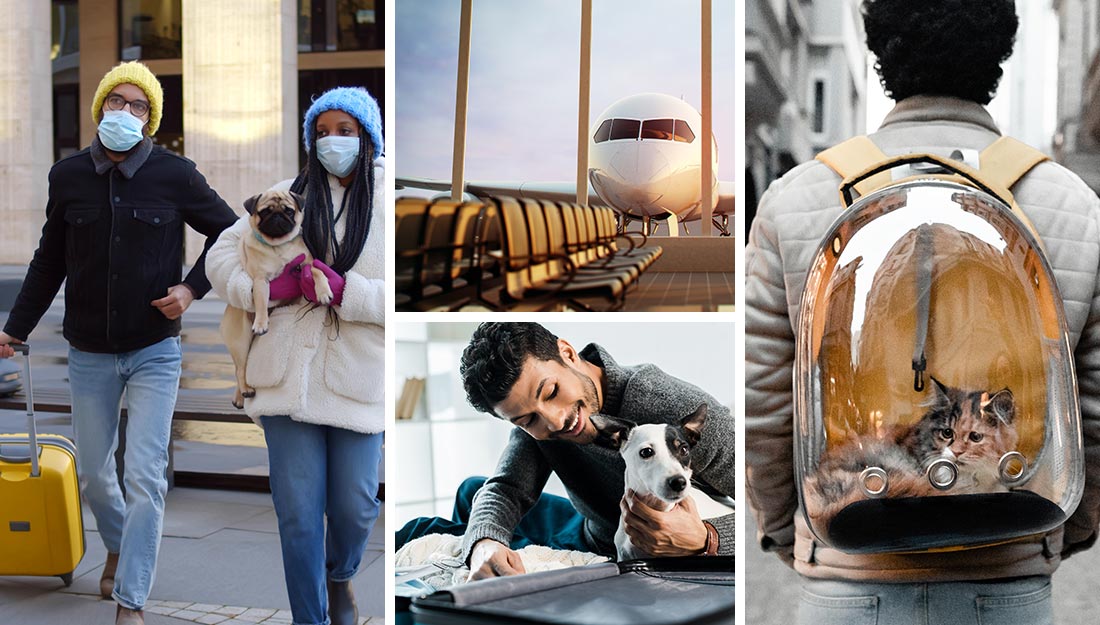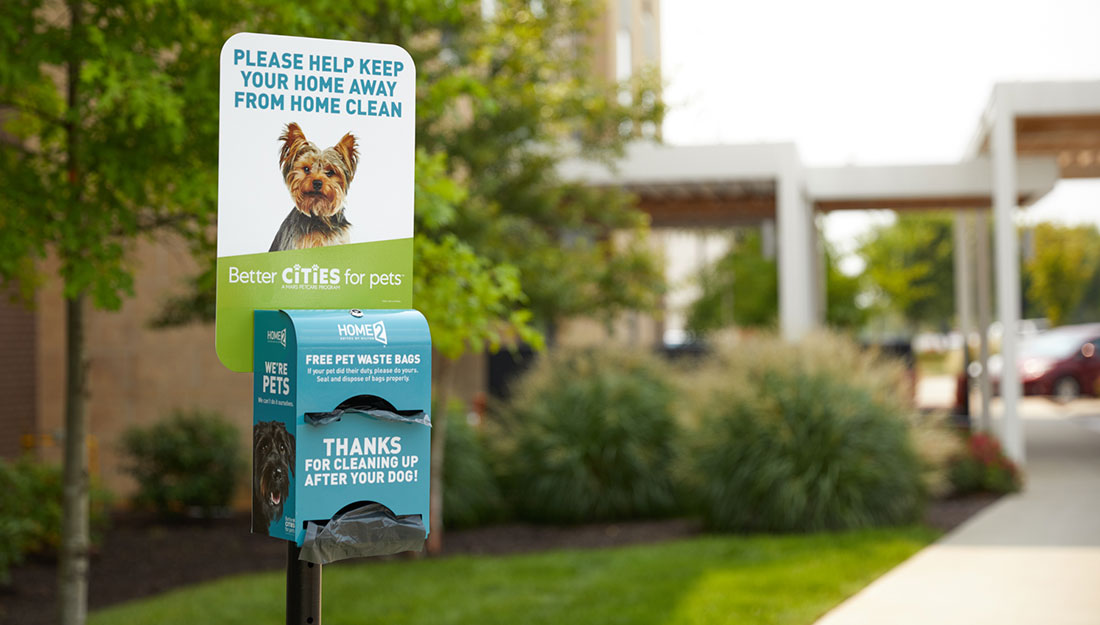Whether by car, train or plane, more and more people are taking their pets along with them on the road. While most people are pros at caring for their pets at home, many are unsure how to care for their pet while traveling. In addition to the pet care basics (food, water, shelter), there are several regional considerations that pet owners should be aware of when taking to the road with their furry companion.
From the dry Midwest to the sandy shores of Southeast, each region poses different risks for travelers. To find out what regional risks exist and what pet owners can do to prepare, the BETTER CITIES FOR PETS™ team spoke with Dr. James Barr, Chief Medical Officer at BluePearl Specialty and Emergency Pet Hospital.
If you are seeking a fun getaway this upcoming travel season, these are a few things you should know.
Red tide in coastal Florida
Red tide, or Karenia brevis (K. brevis), is a microscopic algal that causes “red tide” in the Gulf of Mexico. Generally, red tide needs high salinity water (salt water) to survive. A neurogenic toxin is produced by K. brevis which affects the central nervous systems of fish, causing death.
If ingested by a pet, the K. brevis in a dead fish or shoreline foam can cause neurological, gastrointestinal, or respiratory damage. Symptoms in pets may appear in the form of seizures, vomiting and diarrhea, and/or coughing wheezing. Interestingly, waves and the associated foam contain higher toxin concentration than the water itself. If pets get in the water with red tide, it is important to wash them immediately once returning to land due to the likelihood of them cleaning themselves and ingesting the toxin.
For geriatric pets with underlying respiratory disease, it is important to avoid areas around red tide due to aerosolization (K. brevis carried in the air). If you plan on visiting a beach during a bloom, consider keeping your pets indoors to prevent respiratory irritation.
Although it is best to keep pets off the beach during a red tide bloom, if you decide to bring your pet along, try to avoid high concentration beaches by using the MyFWC interactive map. This map represents the abundance of K. brevis in samples collected statewide over the last eight days and is updated daily.
Hurricanes in coastal states
When a hurricane looms, taking steps like updating or creating a pet disaster kit or planning a pet-friendly evacuation route can help protect your furry friend. Follow these tips to ensure your pet stays safe and healthy when visiting the coastal states this travel season:
- Create a pet emergency kit. There are several items you will want to include in your grab and go pet emergency kit.
- One month’s supply of pet food, water, and medication.
- Hard and digital copies of medical records and registration
- A crate or pet carrier
- A second leash, harness, and/or collar
- Pet litter and litter box (if appropriate)
- Treats, toys, and bedding
- Custom first aid kit to fit your pet’s specific emergency needs
- Special care instructions (in the event you need help caring for your pet during a natural disaster)
- Cleaning supplies for crates and messes
- Update identification tags. There are many opportunities for pets to become lost during an evacuation. Ensure your pet’s collar is secure and ID tags are current. For good measure, you may also want to consider a permanent form of identification such as microchipping as well as registering them in a recovery database.
- Plan out the evacuation route. Like humans, pets need to stop regularly during long trips to hydrate, eliminate and stretch. It is also wise to map out emergency veterinary hospitals along your evacuation route, should your pet experience a medical emergency. Preparing for power outages and water damage, make sure you have both digital and hard copy lists of the veterinary hospitals’ phone numbers and addresses.
- Research your destination. Whether your destination is an evacuation shelter, hotel, or friend or family’s home, make sure your destination is pet-friendly. Some shelters require pet owners to pre-register pets, including uploading current vaccination documents, and space may be limited. Friend or family homes may have existing pets that are not well-tempered around other animals. While it is best practice to have your pet stay with family or friends, there is always the option to board with a local veterinarian or pet groomer.
Venomous snakes from northern to southern states
Snake bites can happen suddenly, bringing shock to both the pet and the owner. As the toxin from the snake bite begins to spread, there will be substantial swelling to the bite area, causing pain and discomfort for the pet.
While snakebite symptoms depend on the size of the pet, the amount of venom, and where the bite occurred, there are several universal signs to look out for:
- Pain
- Local tissue swelling and bruising
- Visible puncture wounds
- Bleeding
- Lethargy and collapse
- Vomiting and diarrhea
The immediate actions taken after your pet has experienced a snake bite are critical. By calling a veterinary hospital ahead of your arrival, you allow the team to prepare as well as to confirm that the hospital has the required antivenin to treat your pet. If you can locate the bite wound, try to keep it below your pet’s heart to discourage the spread of venom. If your pet stops breathing, perform pet CPR.
The risk of snakebites may be decreased by avoiding hiking and walking in areas that are known to harbor venomous snakes. However, in some instances, such places are unknown and cannot be avoided. If you suspect your pet has been bitten by a snake, do not hesitate to bring them into a veterinary ER.
Wildfires
In addition to devastating homes, wildfires impact air quality and cause wildlife to flee to safety. If you happen to find yourself in the path of a wildfire, you will want to consider the potential dangers for your pet. Here are a few tips to keep pets safe during wildfires:
- Limit or avoid exposure to smoke. Whether your pet is healthy or has a heart or lung condition like asthma or bronchitis, it is important to limit their exposure to smoke. Signs of smoke inhalation include agitation, uncoordinated gait, seizures, difficulty breathing, increased breathing rate, coughing, facial swelling, squinting of eyes, skin burns and slow reaction time. Breathing difficulty may gradually get worse over time, so it is important to seek veterinary attention as soon as the pet is exposed to the smoke.
- Watch out for heat exhaustion. Always have water available for your pets and make sure they are kept well-groomed as matted and tangled coats may trap heat in. If you are stationed safely in a surrounding area of a wildfire, make sure you keep walks at a slow pace and take frequent breaks to allow your pet to rest. Signs of heat exhaustion include excessive panting, profuse salivation, glazed eyes or staring, anxiety or restlessness, gums and tongue turn bright red or purple, confusion, trouble standing or walking, collapse or vomiting. If you suspect your pet is having a heatstroke, bring them into a cool area, soak your pet’s body with towels and water, then immediately take them to a veterinary hospital.
- Look out for wildlife. As fires spread, big cats and other wildlife will be displaced. Predatory animals like mountain lions and bobcats are pushed away from fires and closer to residential areas. It is important to keep dogs and cats indoors during a wildfire and keep a keen eye out when taking your pet on walks.
Heat waves
Did you know pets can suffer from heatstroke after something as harmless-sounding as a walk in the park? Pets experience heatstroke when their body absorbs more heat than it can dissipate. This happens either through exercise or exposure to hot temperatures.
Take these tips to ensure your pet does not experience heat stroke:
- Refrain from exercising your pet in the middle of the day.
- On hot days, keep pets indoors.
- Always have water available.
- Keep pets well groomed. Fur may actually trap heat is matted or tangled.
- Maintain pets at a healthy weight.
- Keep the walking pace slow and take rest stops.
Be aware of these pet heatstroke signs:
- Excessive panting
- Profuse salivation
- Glazed eyes or staring
- Anxious or restlessness
- Gums and tongue turn bright red or purple
- Confusion
- Trouble standing or walking
- Collapse
As a serious medical emergency, pets experiencing heatstroke should immediately be taken to a local veterinary hospital for care.
Most BluePearl hospitals are open day and night, seven-days-a-week, and during holidays. Find a local BluePearl here.






 Your Privacy Choices
Your Privacy Choices